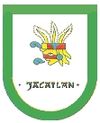Zacatlán
| Zacatlán | ||
|---|---|---|
| City | ||
| Zacatlán de las Manzanas | ||

Main plaza with flower clock
|
||
|
||
| Coordinates: 19°55′55″N 97°57′36″W / 19.93194°N 97.96000°WCoordinates: 19°55′55″N 97°57′36″W / 19.93194°N 97.96000°W | ||
| Country |
|
|
| State | Puebla | |
| Founded | 1562 | |
| Municipal Status | 19th century | |
| Government | ||
| • Municipal President | Mario Alberto Cruz González | |
| Elevation (of seat) | 2,000 m (7,000 ft) | |
| Population (2010) Municipality | ||
| • Municipality | 76,296 | |
| Time zone | CST (UTC-6) | |
| Postal code (of seat) | 73310 | |
| Area code(s) | 975 | |
| Demonym | Zacatecos | |
| Website | [1] | |
Zacatlán (Spanish ![]() ) is a city and municipal seat of Zacatlán Municipality located in the Sierra Norte de Puebla region of Puebla in central Mexico. The area is known for its production of apples, other fruit, cider and fruit wines, which are promoted through the annual Feria de la Manzana and Festival de la Sidra. It is also home to the Relojes Centenario company, the first clock factory in Latin America and the builder of the city’s double sided flower clock in the main square. The historic center of the city is filled with traditional houses with red tile roofs and Zacatlan was designated a “Pueblo Mágico” in 2011. Outside of the city proper, there is a significant indigenous population, the Piedras Encimadas Valley with its rock formations and various waterfalls and ravines.
) is a city and municipal seat of Zacatlán Municipality located in the Sierra Norte de Puebla region of Puebla in central Mexico. The area is known for its production of apples, other fruit, cider and fruit wines, which are promoted through the annual Feria de la Manzana and Festival de la Sidra. It is also home to the Relojes Centenario company, the first clock factory in Latin America and the builder of the city’s double sided flower clock in the main square. The historic center of the city is filled with traditional houses with red tile roofs and Zacatlan was designated a “Pueblo Mágico” in 2011. Outside of the city proper, there is a significant indigenous population, the Piedras Encimadas Valley with its rock formations and various waterfalls and ravines.
The city of Zacatlán is located at an altitude of 2000 meters above sea level in the Sierra Norte de Puebla region of the state, 130 kilometers from the state capital. Its main economic activities relate to agriculture and commerce. The city is next to the Ajajalpan River, a tributary of the Necaxa and whose waters eventually flow into the Gulf of Mexico via the Tecolutla. It is surrounded by hundreds of thousands of apple and other fruit trees, which fill the air with their scent during blossom season. The historic center of the town is marked by large houses and other buildings, some over a hundred years old, with pitched roofs covered in red clay tile, as well as stone paved streets. This and other features of the area and the surrounding area made the city the 39th Pueblo Mágico in Mexico.
...
Wikipedia

